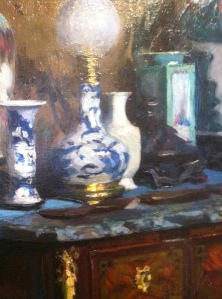AVOID BEAUTIFUL, PLEASANT AND GOOD? but what of Women’s stories?
March 5, 2013 § Leave a comment
I found this on advicetowriters.com:
It’s very hard to write about that which is always beautiful and pleasant and good. You don’t get anywhere with it. There’s no friction in it. There’s no trouble. You have to have trouble. Somebody’s got to get in trouble, or no one wants to read it. (PAUL BOWLES)
Well, I have sat at the feet of many women who just tell about life, leading with the beautiful, the pleasant, the good, and sorta staying on point. It was not their stories so much as the ways and the reasons they told them to me. Multisensory, “listening to grandma”, passing on wisdom stuff. What she wore. Why she loved grandpa.
I have wondered if exactly Bowles’ point, however, that there’s no friction without the opposite of beautiful, pleasant and good, is what drives the male orientation in films.
The article goes on to discuss externalization of internal conflicts- translation, “show don’t tell”, which is so very pertinent for staged and filmed stories. For example, an “I love you” that beams from an actor’s eyes won’t work unless there’s a quick Mr. DeMille close-up interrupting the moment. A close-up can’t possibly be pulled off on stage unless there’s the ubiquitous rock concert video feed screen above it. On live stage, Romeo has to get down on his knees. And apparently dodge apples, or worse, in Shakespeare’s day, thrown from the fickle crowd if he doesn’t bow convincingly.
Okay, no wonder the script and screenwriters lean towards highs and lows and nothing beautiful. I guess audiences through the ages have been tough.
But, look how the first thing I thought, in yammering on about story action, was not only a play from a period in history when even the female monarch wished she were a man, but also “Romeo”, not Juliet.
Romeo fights, climbs vines, declares his love with great swashbuckling. Juliet stabs herself with a dagger, true, but, short of pulling out my dog-eared Shakes and rereading, I don’t immediately recall any other majorly overt acts of Juliet’s. I just know, probably from her words and her interaction with Romeo, that “she loves.” And from the scenes with her nursemaid where we hear how she feels and learn why she shouldn’t feel that.
A script about nothing more than a woman and her nursemaid hanging out in the dressing room, doing hair and adjusting clothes, talking about a guy wouldn’t work. Without flashbacks to violence, flash forwards to the oops, maybe a pregnancy. Maybe a stalker at the window, an orb that holds earth’s secrets suddenly exploding in the closet.
But, back to hanging out with grandmothers, doing nothing, just listening to not very exciting tales. There WAS excitement. There WAS learning. And a center point of the moment, before which came me not knowing and after which I understood her better.
So, what IS good FEMALE STORYTELLING?
I suspect there’s a passive, internal, contained and eternally nourished kind of storytelling that women are not encouraged, in today’s media (plural of medium), to practice. Something that doesn’t play well in the glare of public criticism, for audiences accustomed to “through lines” and beginning-middle-end and action. I suspect real feminine storytelling is something that women themselves avoid in order to succeed. ??
The image I’ve used for this post is a close up of a painting done in 1908 by an American woman, Susan Watkins, who could have been well known but died before her story was fully formed. Died before the 1913 Armory show in NYC that slammed American art onto the international scene. Before she could have matured into a woman willing to tell her stories, in paint, in a more revealing way. Loosen up. Externalize.
The most she reveals here, in this strikingly intimate painting of an interior in her Parisian salon, is her skill with the brush, sanctioned and applauded by the French Academie, and her beautiful, pleasant and good artist’s eye regarding domestic silent moments.
I have researched her extensively, and at first desperately hoped to find friction; to prove that she had met innovators and begun to break out into “the Modern.” Been Mary Cassat and Gertrude Stein, for heaven’s sake. BEEN SOMETHING STORY WORTHY. I found nothing with enough friction to drive me into a Hollywood Blockbuster kinda tale. She died.
And yet, she does have a story. What is it?
